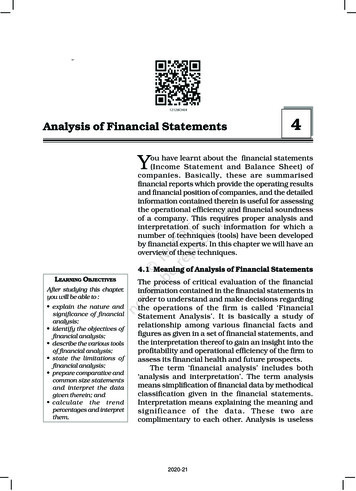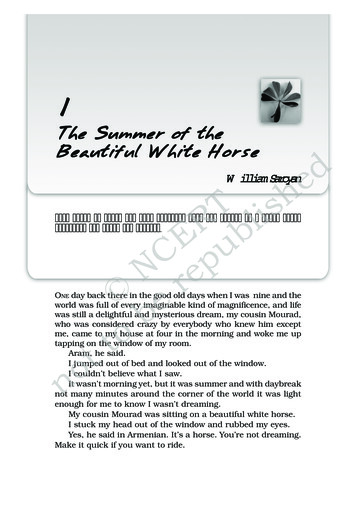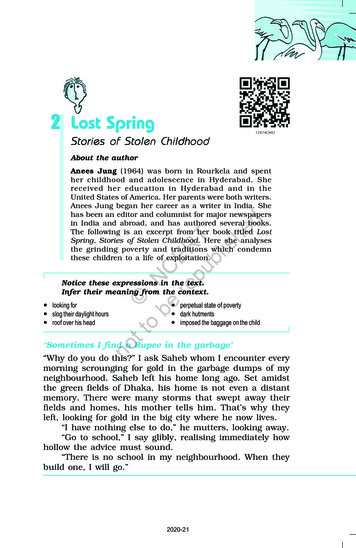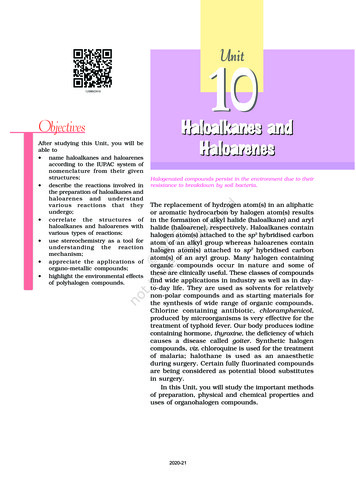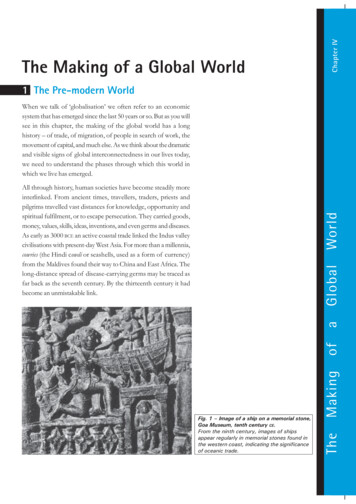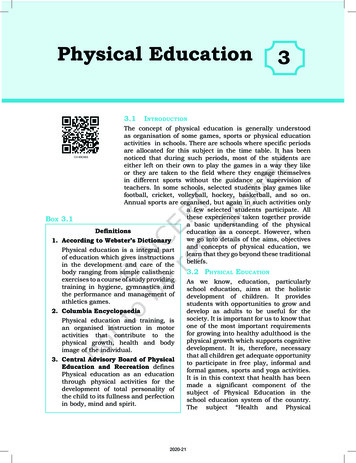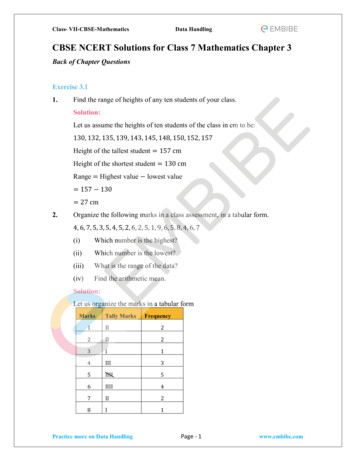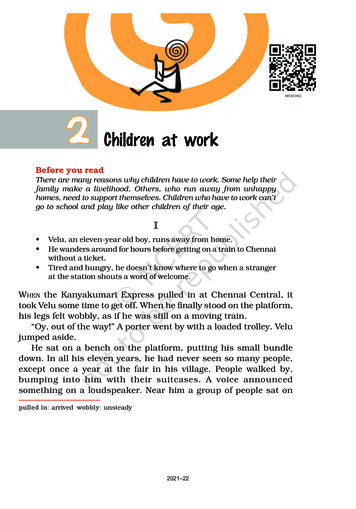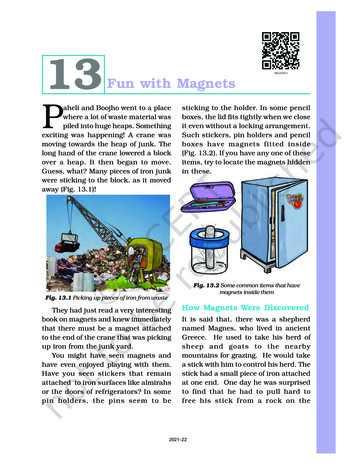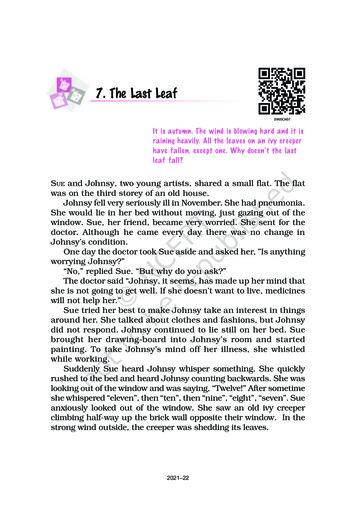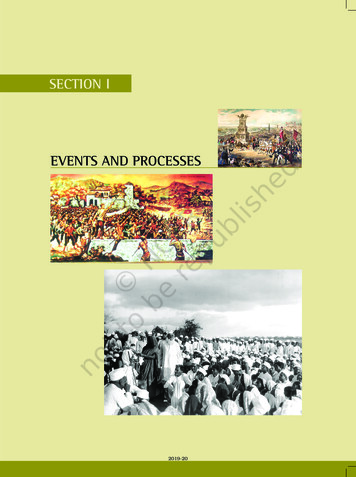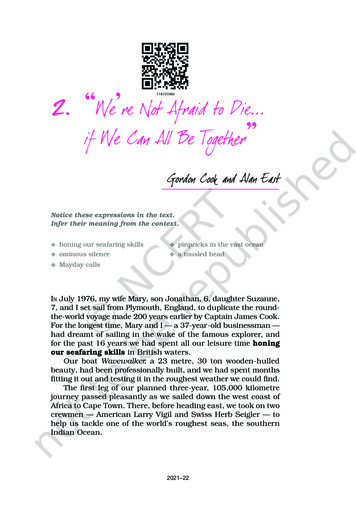
Transcription
“ ’ ” Notice these expressions in the text.Infer their meaning from the context. honing our seafaring skills pinpricks in the vast ocean ominous silence a tousled head Mayday callsIN July 1976, my wife Mary, son Jonathan, 6, daughter Suzanne,7, and I set sail from Plymouth, England, to duplicate the roundthe-world voyage made 200 years earlier by Captain James Cook.For the longest time, Mary and I — a 37-year-old businessman —had dreamt of sailing in the wake of the famous explorer, andfor the past 16 years we had spent all our leisure time honingour seafaring skills in British waters.Our boat Wavewalker, a 23 metre, 30 ton wooden-hulledbeauty, had been professionally built, and we had spent monthsfitting it out and testing it in the roughest weather we could find.The first leg of our planned three-year, 105,000 kilometrejourney passed pleasantly as we sailed down the west coast ofAfrica to Cape Town. There, before heading east, we took on twocrewmen — American Larry Vigil and Swiss Herb Seigler — tohelp us tackle one of the world’s roughest seas, the southernIndian Ocean.2021–22
14HORNBILLOn our second day out of Cape Town, we began to encounterstrong gales. For the next few weeks, they blew continuously.Gales did not worry me; but the size of the waves was alarming —up to 15 metres, as high as our main mast.December 25 found us 3,500 kilometres east of Cape Town.Despite atrocious weather, we had a wonderful holiday completewith a Christmas tree. New Year’s Day saw no improvement inthe weather, but we reasoned that it had to change soon. And itdid change — for the worse.At dawn on January 2, the waves were gigantic. We weresailing with only a small storm jib and were still making eightknots. As the ship rose to the top of each wave we could seeendless enormous seas rolling towards us, and the screamingof the wind and spray was painful to the ears. To slow the boatdown, we dropped the storm jib and lashed a heavy mooringrope in a loop across the stern. Then we double-lashedeverything, went through our life-raft drill, attached lifelines,donned oilskins and life jackets — and waited.The first indication of impending disaster came at about6 p.m., with an ominous silence. The wind dropped, and thesky immediately grew dark. Then came a growing roar, and anenormous cloud towered aft of the ship. With horror, I realisedthat it was not a cloud, but a wave like no other I had ever seen.It appeared perfectly vertical and almost twice the height of theother waves, with a frightful breaking crest.The roar increased to a thunder as the stern moved up theface of the wave, and for a moment I thought we might ride overit. But then a tremendous explosion shook the deck. A torrentof green and white water broke over the ship, my head smashedinto the wheel and I was aware of flying overboard and sinkingbelow the waves. I accepted my approaching death, and as Iwas losing consciousness, I felt quite peaceful.Unexpectedly, my head popped out of the water. A few metresaway, Wavewalker was near capsizing, her masts almosthorizontal. Then a wave hurled her upright, my lifeline jerkedtaut, I grabbed the guard rails and sailed through the air intoWavewalker’s main boom. Subsequent waves tossed me aroundthe deck like a rag doll. My left ribs cracked; my mouth filledwith blood and broken teeth. Somehow, I found the wheel, linedup the stern for the next wave and hung on.Water, Water, Everywhere. I could feel that the ship had waterbelow, but I dared not abandon the wheel to investigate. Suddenly,2021–22
WE’RE NOT AFRAIDTODIE .15the front hatch was thrown open and Mary appeared. “We’re sinking!”she screamed. “The decks are smashed; we’re full of water.”“Take the wheel”, I shouted as I scrambled for the hatch.Larry and Herb were pumping like madmen. Broken timbershung at crazy angles, the whole starboard side bulged inwards;clothes, crockery, charts, tins and toys sloshed about in deep water.I half-swam, half-crawled into the children’s cabin. “Are youall right?” I asked. “Yes,” they answered from an upper bunk.“But my head hurts a bit,” said Sue, pointing to a big bumpabove her eyes. I had no time to worry about bumped heads.After finding a hammer, screws and canvas, I struggled backon deck. With the starboard side bashed open, we were takingwater with each wave that broke over us. If I couldn’t makesome repairs, we would surely sink.Somehow I managed to stretch canvas and secure waterproofhatch covers across the gaping holes. Some water continued tostream below, but most of it was now being deflected over the side.More problems arose when our hand pumps started to blockup with the debris floating around the cabins and the electricpump short-circuited. The water level rose threateningly. Backon deck I found that our two spare hand pumps had beenwrenched overboard — along with the forestay sail, the jib, thedinghies and the main anchor.Then I remembered we had another electric pump underthe chartroom floor. I connected it to an out-pipe, and wasthankful to find that it worked.The night dragged on with an endless, bitterly cold routineof pumping, steering and working the radio. We were getting noreplies to our Mayday calls — which was not surprising in thisremote corner of the world.Sue’s head had swollen alarmingly; she had two enormousblack eyes, and now she showed us a deep cut on her arm.When I asked why she hadn’t made more of her injuries beforethis, she replied, “I didn’t want to worry you when you weretrying to save us all.”By morning on January 3, the pumps had the water levelsufficiently under control for us to take two hours’ rest inrotation. But we still had a tremendous leak somewhere belowthe waterline and, on checking, I found that nearly all the boat’s2021–22
16HORNBILLmain rib frames were smashed down to the keel. In fact, therewas nothing holding up a whole section of the starboard hullexcept a few cupboard partitions.We had survived for 15 hours since the wave hit, butWavewalker wouldn’t hold together long enough for us to reachAustralia. I checked our charts and calculated that there weretwo small islands a few hundred kilometres to the east. One ofthem, Ile Amsterdam, was a French scientific base. Our onlyhope was to reach these pinpricks in the vast ocean. But unlessthe wind and seas abated so we could hoist sail, our chanceswould be slim indeed. The great wave had put our auxilliaryengine out of action.On January 4, after 36 hours of continuous pumping, wereached the last few centimetres of water. Now, we had only tokeep pace with the water still coming in. We could not set anysail on the main mast. Pressure on the rigging would simplypull the damaged section of the hull apart, so we hoisted thestorm jib and headed for where I thought the two islands were.Mary found some corned beef and cracker biscuits, and we ateour first meal in almost two days.But our respite was short-lived. At 4 p.m. black clouds beganbuilding up behind us; within the hour the wind was back to 40knots and the seas were getting higher. The weather continuedto deteriorate throughout the night, and by dawn on January 5,our situation was again desperate.When I went in to comfort the children, Jon asked, “Daddy,are we going to die?” I tried to assure him that we could make it.“But, Daddy,” he went on, “we aren’t afraid of dying if we can allbe together — you and Mummy, Sue and I.”I could find no words with which to respond, but I left thechildren’s cabin determined to fight the sea with everything Ihad. To protect the weakened starboard side, I decided to heaveto — with the undamaged port hull facing the oncoming waves,using an improvised sea anchor of heavy nylon rope and two 22litre plastic barrels of paraffin.That evening, Mary and I sat together holding hands, as themotion of the ship brought more and more water in through thebroken planks. We both felt the end was very near.But Wavewalker rode out the storm and by the morning ofJanuary 6, with the wind easing, I tried to get a reading on thesextant. Back in the chartroom, I worked on wind speeds,2021–22
WE’RE NOT AFRAIDTODIE .17changes of course, drift and current in an effort to calculate ourposition. The best I could determine was that we were somewherein 150,000 kilometres of ocean looking for a 65 kilometre-wideisland.While I was thinking, Sue, moving painfully, joined me. Theleft side of her head was now very swollen and her blackenedeyes narrowed to slits. She gave me a card she had made.On the front she had drawn caricatures of Mary and mewith the words: “Here are some funny people. Did they makeyou laugh? I laughed a lot as well.” Inside was a message: “Oh,how I love you both. So this card is to say thank you and let’shope for the best.” Somehow we had to make it.I checked and rechecked my calculations. We had lost our maincompass and I was using a spare which had not been correctedfor magnetic variation. I made an allowance for this and anotherestimate of the influence of the westerly currents which flowthrough this part of the Indian Ocean.About 2 p.m., I went on deck and asked Larry to steer acourse of 185 degrees. If we were lucky, I told him with aconviction I did not feel, he could expect to see the island atabout 5 p.m.Then with a heavy heart, I went below, climbed on my bunkand amazingly, dozed off. When I woke it was 6 p.m., and growingdark. I knew we must have missed the island, and with the sailwe had left, we couldn’t hope to beat back into the westerly winds.At that moment, a tousled head appeared by my bunk. “Can Ihave a hug?” Jonathan asked. Sue was right behind him.“Why am I getting a hug now?” I asked.“Because you are the best daddy in the whole world — andthe best captain,” my son replied.“Not today, Jon, I’m afraid.”“Why, you must be,” said Sue in a matter-of-fact voice. “Youfound the island.”“What!” I shouted.“It’s out there in front of us,” they chorused, “as big as abattleship.”I rushed on deck and gazed with relief at the stark outline ofIle Amsterdam. It was only a bleak piece of volcanic rock, withlittle vegetation — the most beautiful island in the world!2021–22
18HORNBILLWe anchored offshore for the night, and the next morning all28 inhabitants of the island cheered as they helped us ashore.With land under my feet again, my thoughts were full ofLarry and Herbie, cheerful and optimistic under the direst stress,and of Mary, who stayed at the wheel for all those crucial hours.Most of all, I thought of a seven-year-old girl, who did not wantus to worry about a head injury (which subsequently took sixminor operations to remove a recurring blood clot between skinand skull), and of a six-year-old boy who was not afraid to die.Understanding the text1. List the steps taken by the captain(i) to protect the ship when rough weather began.(ii) to check the flooding of the water in the ship.2. Describe the mental condition of the voyagers on 4 and 5 January.3. Describe the shifts in the narration of the events as indicated inthe three sections of the text. Give a subtitle to each section.Talking about the textDiscuss the following questions with your partner.1. What difference did you notice between the reaction of the adultsand the children when faced with danger?2. How does the story suggest that optimism helps to endure “thedirest stress”?3. What lessons do we learn from such hazardous experiences whenwe are face-to-face with death?4. Why do you think people undertake such adventurous expeditionsin spite of the risks involved?Thinking about language1. We have come across words like ‘gale’ and ‘storm’ in the account.Here are two more words for ‘storm’: typhoon, cyclone. How manywords does your language have for ‘storm’?2021–22
WE’RE NOT AFRAIDTODIE .192. Here are the terms for different kinds of vessels: yacht, boat, canoe,ship, steamer, schooner. Think of similar terms in your language.3. ‘Catamaran’ is a kind of a boat. Do you know which Indianlanguage this word is derived from? Check the dictionary.4. Have you heard any boatmen’s songs? What kind of emotionsdo these songs usually express?Working with words1. The following words used in the text as ship terminology arealso commonly used in another sense. In what contexts wouldyou use the other meaning?knotsternboomhatchanchor2. The following three compound words end in -ship. What doeseach of them mean?airshipflagshiplightship3. The following are the meanings listed in the dictionary againstthe phrase ‘take on’. In which meaning is it used in the thirdparagraph of the account:take on sth:to begin to have a particular quality orappearance; to assume sthtake sb on:to employ sb; to engage sbto accept sb as one’s opponent in a game,contest or conflicttake sb/sth on:to decide to do sth; to allow sth/sb to entere.g. a bus, plane or ship; to take sth/sbon boardThings to do1. Given on the next page is a picture of a yacht. Label the parts ofthe yacht using the terms given in the box.2021–22
st2. Here is some information downloaded from the Internet on IleAmsterdam. You can view images of the isle if you go online.LocationSouth Indian Ocean, betweensouthernmost parts of Australia andSouth AfricaLatitude and longitude37 92 S, 77 67 ESovereigntyFrancePolitical status notesPart of Fr ench Souther n andAntarctic LandsPopulation35Census notesMeteorological station staffLand area in squarekilometres863. Locate Ile Amsterdam on the world map.2021–22
WE’RE NOT AFRAIDTODIE .21NotesThis is a first person account of an adventurous ordeal that a familyexperiences.Understanding the textThis section deals with factual and global comprehension. Practice isgiven in describing and noticing text organisation.Talking about the textPeer interaction about subjective responses to the text; empathy withand comment on universal experiences; and human behaviour relatedto risk-taking and adventure.Thinking about language Variety of terms for a particular item in different languages English words derived from Indian languages Linking language to music (boatmen’s songs)Working with words ‘Ship’ terms as homonyms. Compound words with ‘-ship’ with different connotations Phrasal verbsThings to do Honing reference skills by finding facts from the Internet, theencyclopedia, and mapsExposure to various genres of fact presentation2021–22
conviction I did not feel, he could expect to see the island at about 5 p.m. Then with a heavy heart, I went below, climbed on my bunk and amazingly, dozed off. When I woke it was 6 p.m., and growing dark. I knew we must have missed the island, and with the sail we had lef
